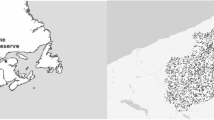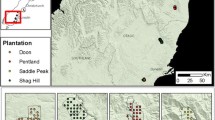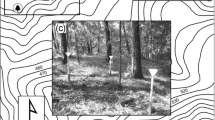Abstract
Variations in vertical and horizontal forest structure are often difficult to quantify as field-based methods are labour intensive and passive optical remote sensing techniques are limited in their capacity to distinguish structural changes occurring below the top of the canopy. In this study the capacity of small footprint (0.19 cm), discrete return, densely spaced (0.7 hits/m−2), multiple return, Light Detection and Ranging (LiDAR) technology, to measure foliage height and to estimate several stand and canopy structure attributes is investigated. The study focused on six Douglas-fir [Pseudotsuga menziesii spp. menziesii (Mirb.) Franco] and western hemlock [Tsuga heterophylla (Raf.) Sarg.] stands located on the east coast of Vancouver Island, British Columbia, Canada, with each stand representing a different structural stage of stand development for forests within this biogeoclimatic zone. Tree height, crown dimensions, cover, and vertical foliage distributions were measured in 20 m × 20 m plots and correlated to the LiDAR data. Foliage profiles were then fitted, using the Weibull probability density function, to the field measured crown dimensions, vertical foliage density distributions and the LiDAR data at each plot. A modified canopy volume approach, based on methods developed for full waveform LiDAR observations, was developed and used to examine the vertical and horizontal variation in stand structure. Results indicate that measured stand attributes such as mean stand height, and basal area were significantly correlated with LiDAR estimates (r 2 = 0.85, P < 0.001, SE = 1.8 m and r 2 = 0.65, P < 0.05, SE = 14.8 m2 ha−1, respectively). Significant relationships were also found between the LiDAR data and the field estimated vertical foliage profiles indicating that models of vertical foliage distribution may be robust and transferable between both field and LiDAR datasets. This study demonstrates that small footprint, discrete return, LiDAR observations can provide quantitative information on stand and tree height, as well as information on foliage profiles, which can be successfully modelled, providing detailed descriptions of canopy structure.







Similar content being viewed by others
References
Aber JD (1979a) Foliage-height profiles and succession in northern hardwood forests. Ecology 60:18–23
Aber JD (1979b) A method for measuring foliage-height profiles in broad-leaved forests. J Ecol 67:35–40
Axelsson P (1999) Processing of laser scanner data—algorithms and applications. ISPRS J Photogramm Remote Sens 54:138–147
Bailey RL, Dell TR (1973) Quantifying diameter distributions with the Weibull distribution. For Sci 19:97–104
Barclay HJ, Goodman D (2000) Conversion of total to projected leaf area index in conifers. Can J Bot 78:447–454
Biging GS, Dobbertin M (1992) A comparison of distance dependent competition measures for height and basal area growth of individual conifer trees. For Sci 38:695–720
Blair JB, Rabine DL, Hofton MA (1999) The laser vegetation imaging system; a medium-altitude digitisation-only airborne laser altimeter for mapping vegetation and topography. ISPRS J Photogramm Remote Sens 54:115–122
Brokaw N, Lent R (1999) Vertical structure. In: Hunter M (ed) Maintaining biodiversity in forest ecosystems. Cambridge University Press, Boston, pp 373–399
Chasan J, Baldocchi D, Huston M (1991) A comparison of direct and indirect methods for estimating forest canopy leaf area. Agric For Meteorol 57:107–128
Chen JM, Rich PM, Gower TS, Norman JM, Plummer S (1997) Leaf area index of boreal forests: theory techniques and measurements. J Geophys Res 102(D24):29429–29444
Chen JM, Paw UKT, Ustin SL, Suchanek TH, Bond BJ, Brosofske KD, Falk M (2004) Net ecosystem exchanges of carbon water and energy in young and old-growth Douglas-fir forests. Ecosystems 7:534–544
Coops NC, Smith ML, Jacobson K, Martin M, Ollinger S (2004a) Estimation of leaf area index using three techniques in a mature native eucalypt canopy. Aust Ecol 29:332–341
Coops NC, Wulder MA, Culvenor DC, St-Onge B (2004b) Comparison of forest attributes extracted from fine spatial resolution multi-spectral and LiDAR data. Can J Remote Sens 30:855–866
Cohen WB, Spies TA (1992) Estimating structural attributes of Douglas Fir/Western Hemlock forest stands from Landsat and SPOT imagery. Remote Sens Environ 41:1–17
Demarchi DA (1996) An introduction to the ecoregions of British Columbia Victoria: BC Ministry of Environment Lands and Parks. http://www.envgovbcca/rib/wis/eco
Franklin JF, Spies TA, Van Pelt R, Carey A, Thornburgh D, Burg DR, Lindenmayer D (2002) Disturbances and the structural development of natural forest ecosystems with some implications for silviculture. For Ecol Manage 155:399–423
Gering LR (1995) The relationship of diameter at breast height and crown diameter for four species groups in Hardin County Tennessee. South J Appl For 19:177–181
Gillespie AR, Allen HL, Vose JM (1994) Amount and vertical distribution of foliage of young loblolly pine trees as affected by canopy position and silvicultural treatment. Can J For Res 24:1337–1344
Goodwin G (1937) Regeneration Study on the logged-off lands of the Comox Logging and Railway Company Oyster River Forest Survey No R 72 Survey file No 0124780 BC Forest Service 39p and Map
Gower ST, Norman JM (1991) Rapid estimation of leaf area index in conifer and broad-leaf plantations. Ecology 72:1896–1900
Green RN, Klinka K (1994) A Field Guide to Site Identification and Interpretation for the Vancouver Forest Region: Land Management Handbook # 28 Victoria: Province of British Columbia
Harding DJ, Lefsky MA, Parker GG, Blair JB (2001) Laser altimeter canopy height profiles method and validation for closed-canopy broadleaf forests. Remote Sens Environ 76:283–297
Hall SA, Burke IC, Box DO, Kaufmann MR, Stoker JM (2005) Estimating stand structure using discrete-return lidar: an example from low density fire prone ponderosa pine forests. For Ecol Manage 208:189–209
Harmon ME, Franklin JF, Swanson FJ, Sollins P, Gregory SV, Lattin JD, Anderson NH, Cline SP, Aumen NG, Sedell JR, Lienkaemper GW, Cromack K Jr, Cummins KW (1986) Ecology of coarse woody debris in temperate ecosystems. In: MacFadyen A, Ford ED (eds) Advances in ecological research. Academic, Orlando Florida 15:133–302
Hutchinson MF (1989) A new procedure for gridding elevation and stream line data with automatic removal of spurious pits. J Hydrol 106:211–232
Hyyppä J, Hyyppä H, Inkinen M, Engdahl M, Linko S, Zhu Y-H (2000) Accuracy comparison of various remote sensing data sources in the retrieval of forest stand attributes. For Ecol Manage 128:109–120
Kershaw JA Jr, Maguire DA (1995) Crown structure in western hemlock Douglas-fir and grand fir in western Washington: trends in branch-level mass and leaf area. Can J For Res 25:1897–1912
Kraus K, Pfeifer N (1999) Determination of terrain models in wooded areas with airborne scanner data. ISPRS J Photogramm Remote Sens 54:193–203
Lim K, Treitz P, Wulder MA, St-Onge B, Flood M (2003) LiDAR remote sensing of forest structure. Progress Phys Geogr 27:88–106
Lefsky MA, Harding D, Cohen WB, Parker G, Shugart HH (1998) Surface LiDAR remote sensing of Basal area and biomass in deciduous forests of eastern Maryland USA. Remote Sens Environ 67:83–98
Lefsky MA, Cohen WB, Acker SA, Parker GG, Spies TA, Harding D (1999) LiDAR remote sensing of the canopy structure and biophysical properties of Douglas-Fir Western Hemlock Forests. Remote Sens Environ 70:339–361
Lefsky MA, Hudak AT, Cohen WB, Acker SA (2005) Geographic variability in lidar predictions of forest stand structure in the Pacific Northwest. Remote Sens Environ 95:532–548
Lovell JL, Jupp DLB, Culvenor DS, Coops NC (2003) Using airborne and ground-based ranging lidar to measure canopy structure in Australian forests. Can J Remote Sens 29:1–16
MacArthur RH, Horn HS (1969) Foliage profile by vertical measurements. Ecology 50:802–804
MacKinnon A (2003) West-coast temperate old-growth forests. For Chron 79:475–484
Magnussen S, Boudewyn P (1998) Derivations of stand heights from airborne laser scanner data with canopy-based quantile estimators. Can J For Res 28:1016–1031
Magnussen S, Eggermont P, LaRiccia V (1999) Recovering tree heights from airborne laser scanner data. For Sci 45:407–422
Morrison ML, Timosse IM, With KA (1987) Development and testing of linear regression models predicting bird-habitat relationships. J Wildl Manage 51:247–253
Næsset E (1997) Determination of mean tree height of forest stands using airborne laser scanner data. ISPRS J Photogramm Remote Sens 52:49–56
Næsset E (2002) Predicting forest stand characteristics with airborne scanning laser using a practical two-stage procedure with field data. Remote Sens Environ 80:88–99
Næsset E, Økland T (2002) Estimating tree height and tree crown properties using airborne scanning laser in a boreal nature reserve. Remote Sens Environ 79:105–115
Næsset E, Gobakken T, Holmgren J, Hyyppä H, Hyypää J, Maltamo M, Nilsson M, Olsson H, Persson Å, Söderman U (2004) Laser scanning of forest resources: the Nordic experience. Scand J For Res 19:482–499
Ni-Meister W, Jupp D, Dubayah R (2001) Modeling LiDAR waveforms in heterogeneous and discrete canopies. IEEE Trans Geosci Remote Sens 39:1943–1957
Parker GG, Harmon ME, Lefsky MA, Chen JQ, Van Pelt R, Weis SB, Thomas SC, Winner WE, Shaw DC, Franklin JF (2004) Three-dimensional structure of an old-growth Pseudotsuga-Tsuga canopy and its implications for radiation balance microclimate and gas exchange. Ecosystems 7:440–453
Persson A, Holmgren H, Söderman U (2002) Detecting and measuring individual trees using an airborne Laser scanner. Photogramm Eng Remote Sens 68:925–932
Pojar J, MacKinnon A (1994) Plants of coastal British Columbia including Washington Oregon and Alaska Lonepine Press, Vancouver BC
Pojar J, Klinka K, Demarchi DA (1991) Coastal Western Hemlock Zone. In Meidinger D, Pojar J (eds) Ecosystems of British Columbia. BC Special Report Series No 6 Victoria: BC Ministry of Forests, pp 95–111
Radtke P, Bolstad P (2001) Laser point-quadrant sampling for estimating foliage-height profiles in broad-leaved forests. Can J For Res 31:410–418
Rhoads AG, Hamburg SP, Fahey TJ, Siccama TG, Kobe R (2004) Comparing direct and indirect methods of assessing canopy structure in a northern hardwood forest. Can J For Res 34:584–591
Riano D, Meier E, Allgower B, Chuvieco E, Ustin SL (2003) Modeling airborne laser scanning data for the spatial generation of critical forest parameters in fire behaviour modelling. Remote Sens Environ 86:177–186
Richards PW (1983) The three dimensional structure of tropical rain forest. In: Sutton SL, Whitmore TC, Chadwick AC (eds) Tropical rain forest: ecology and management. Blackwell, Oxford, pp 3–10
Schenk T, Seo S, Csatho B (2001) Accuracy study of airborne LASER scanning data with photogrammetry. Int Arch Photogramm Remote Sens XXXIV-3/W4:113–118
Seischab FK, Bernard JM, Eberle MD (1993) Glaze storm damage to western New York forest communities. Bull Torrey Bot Club 120:64–72
Smith ML, Martin ME (2001) A plot-based method for rapid estimation of forest canopy chemistry. Can J For Res 31:549–55
St Onge B, Treitz P, Wulder MA (2003) Tree and canopy height estimation with scanning Lidar. In: Wulder MA, Franklin SE (eds) Remote sensing of forest environments: concepts and case studies. Kluwar, Boston, pp 489–509
Taylor S (2002) British Columbia Natural Disturbance Database. http://www.pfccfsnrcangcca/fires/disturbance/index_ehtml
Van Pelt R, Nadkarni NM (2004) Horizontal and vertical distribution of canopy structural elements of Pseudotsuga menziesii forests in the Pacific Northwest. For Sci 50:326–341
Vose JM (1988) Patterns of leaf area distribution within crowns of nitrogen- and phosphorus-fertilized loblolly pine trees. For Sci 34:564–573
Walker J, Hopkins MS (1990) Vegetation. In: McDonald RC, Isbell RF, Speight JG, Walker J, Hopkins MS (eds) Australian soil and land survey: field handbook, 2nd edn. Inkata Press, Melbourne
Waring RH, Law B, Goulden ML, Bassow SL, McCreight RW, Wofsy SC, Bazzaz FA (1995) Scaling gross ecosystem production at Harvard Forest with remote sensing: a comparison of estimates from a constrained quantum-use efficiency model and eddy correlation. Plant Cell Environ 18:1201–1213
Warren Wilson J (1960) Inclined point quadrats. New Phytol 59:1–8
Warren Wilson J (1963) Estimation of foliage denseness and foliage angle by inclined point quadrats. Aust J Bot 11:95–105
Whitney HE, Johnson WC (1984) Ice storms and forest succession in southwestern Virginia. Bull Torrey Bot Soc 111:429–437
Xu M, Harrington TB (1998) Foliage biomass distribution of loblolly pine as affected by tree dominance crown size and stand characteristics. Can J For Res 28:887–892
Yu X, Hyypa J, Kaartinen H, Maltamo M (2004) Automatic detection of harvested trees and determination of forest growth using airborne laser scanning. Remote Sens Environ 90:451–462
Zimble DA, Evans DL, Carlson GC, Parker RC, Grado SC, Gerand PD (2003) Characterizing vertical forest structure using small-footprint airborne LiDAR. Remote Sens Environ 87:171–182
Acknowledgments
We thank David Seeman, Bob Ferris (Canadian Forest Service) and Rachelle Lalonde (UBC) for field assistance. Prof. Andy Black and staff allowed access to the FLUXNET—Canada site. We thank forest companies Timberwest and Weyerhaeuser for providing access to their forest inventories of the area and access to their private lands. We acknowledge staff from the CSIRO Canopy LiDAR project, in particular Dr. Jenny Lovell, for assistance with the development of the in-house software used for the analysis of the LiDAR data. The LiDAR data was acquired by Benoît St-Onge as part of an ongoing collaborative project with funds provided by NSERC and BIOCAP. Components of this research were also funded by a NSERC Discovery grant to Coops and DAAD post-graduate scholarship to Hilker. Preparation of the combined forest inventory and disturbance coverages was done partially through Action Plan 2000 and FLUXNET—CCAF funding to T. Trofymow. Finally, we are grateful to the two anonymous reviewers who provided editorial suggestions.
Author information
Authors and Affiliations
Corresponding author
Additional information
Communicated by R.K. Monson.
Rights and permissions
About this article
Cite this article
Coops, N.C., Hilker, T., Wulder, M.A. et al. Estimating canopy structure of Douglas-fir forest stands from discrete-return LiDAR. Trees 21, 295–310 (2007). https://doi.org/10.1007/s00468-006-0119-6
Received:
Revised:
Accepted:
Published:
Issue Date:
DOI: https://doi.org/10.1007/s00468-006-0119-6




